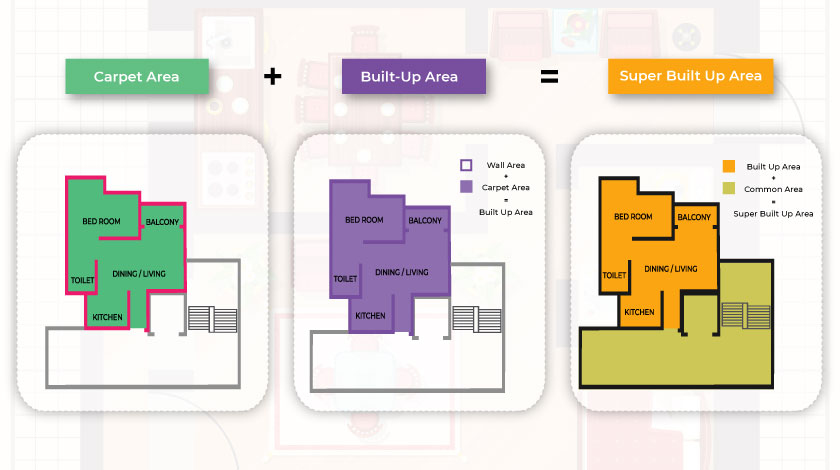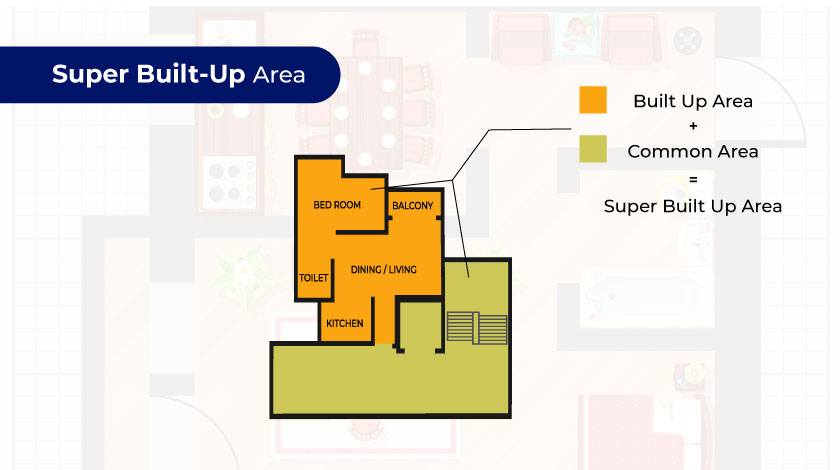Built-up Area vs. Super Built-up Area - What You Need to Know

Measurements like built-up area and super built-up area significantly impact the valuation, pricing, and overall perception of a property, making it essential to grasp their definitions and differences.
The knowledge of these property measurement terms equips buyers with the information needed to navigate the market confidently and make choices that align with their needs and financial goals.
What is Super Built-up Area?

The super built-up area is the sum of the built-up area and a proportionate share of the common amenities and spaces. This comprehensive measurement provides a more holistic view of the total space available to a property owner, both privately and communally.
Components Included in the Super Built-up Area
The super built-up area meaning encompasses several key components, including:
- Built-up Area: The actual usable area within the walls of the property, including the living space, internal walls, balconies, and terraces.
- Common Areas: Shared spaces within the building that enhance the living experience. These include:
- Lobbies: The entrance and common sitting areas.
- Staircases: The stairwells used by all residents.
- Lift Shafts: The space occupied by elevators.
- Corridors: Hallways connecting different parts of the building.
- Clubhouses and Gyms: Amenities provided for the residents’ use.
- Swimming Pools and Gardens: Recreational areas within the complex.
Example Calculation to Illustrate Super Built-up Area
To understand the super built area meaning with a practical example, let’s consider a residential apartment:
- Built-up Area: 1,200 square feet
- Common Areas: The total common area of the building is 10,000 square feet, and there are 100 apartments in the building.
To calculate the super built-up area, the proportionate share of the common areas is added to the built-up area. This share is typically divided equally among all apartments.
- Proportionate Share of Common Areas: 10,000 square feet / 100 apartments = 100 square feet per apartment.
So, the super built-up area for this apartment would be:
- Super Built-up Area: 1,200 square feet (built-up area) + 100 square feet (proportionate share of common areas) = 1,300 square feet.
Key Differences Between Built-up Area and Super Built-up Area
The distinctions impact how properties are valued and priced, influencing buyers’ perceptions and financial commitments. Below is a side-by-side comparison highlighting the key differences between these two property measurements.
| Aspect | Built-up Area | Super Built-up Area |
|---|---|---|
| Definition | The built-up area includes the total space within the walls of the property, encompassing the living space, walls, balconies, and terraces. | The super built-up area includes the built-up area plus a proportionate share of common areas such as lobbies, staircases, lift shafts, and amenities. |
| Inclusion Criteria | Includes only the private, usable areas of the property. | Encompasses private usable areas along with a portion of the shared spaces within the building or complex. |
| Usage in Property Valuation | Primarily used to determine the actual living space available to the owner, providing a straightforward measure of the property’s size. | Offers a more comprehensive view of the property's total usable area, including both private and shared spaces, thus giving a fuller picture of the property's value. |
| Impact on Pricing | Typically, this results in a lower price per square foot as it only considers the private living areas. | Usually, this leads to a higher price per square foot due to the inclusion of shared amenities and common areas, reflecting the added value of these features. |
Note: Understanding the definition of super built-up area and the built-up area is essential for accurately assessing property value and making informed purchasing decisions.
Also read: The Key Differences Between Built Up Area and Carpet Area
Importance of Knowing the Difference
Understanding the difference between built-up area and super built-up area is crucial for homebuyers and investors alike. Here’s why:
Why Homebuyers Should Be Aware of These Terms
- Informed Decision Making: Knowing these terms helps buyers make informed decisions about the actual space they will get. This knowledge is essential for comparing different properties and understanding what is included in the price.
- Avoiding Misunderstandings: Awareness of these terms prevents misunderstandings and potential disputes with sellers or developers. Buyers can ensure they are not misled by the advertised size of the property.
Impact on Property Selection and Investment Decisions
- Accurate Property Evaluation: Understanding the built-up and super built-up areas enables buyers to accurately evaluate properties. This helps in selecting a property that truly meets their needs and preferences.
- Financial Planning: Knowledge of these measurements aids in better financial planning. Buyers can estimate the actual cost per square foot and assess whether a property is worth the investment.
- Comparing Offers: It allows for an apples-to-apples comparison between different properties and developers. Buyers can see which offers the best value for money by comparing the usable space versus the shared amenities.
Legal and Financial Implications
- Transparency in Transactions: A clear understanding of these areas ensures transparency in real estate transactions. Buyers can verify that the space they are paying for matches the legal and financial documentation.
- Compliance with Regulations: Awareness of these terms helps buyers ensure that the property complies with local building regulations and codes. This is particularly important for legal and financial security.
- Future Resale Value: Knowing the exact measurements can impact the future resale value of the property. Buyers can better negotiate prices when selling their property, backed by accurate information about the built-up and super built-up areas.
How to Calculate These Areas
Here’s a step-by-step guide on how to calculate these areas along with useful tools and resources for accurate measurement.
Step-by-step Guide on Calculating Built-up Area
- Measure the Total Area: Start by measuring the total area within the external walls of the property, including all rooms, balconies, and terraces.
- Include Internal Walls: Add the area covered by internal walls. This includes walls between rooms but not shared walls with neighboring units.
- Exclude External Walls: Do not include the thickness of external walls in your calculation.
Include Balcony and Terrace Areas: Include the full area of balconies and terraces if they are exclusively accessible to the unit.
Example Calculation:
- Living Room: 300 sq ft
- Bedroom: 200 sq ft
- Kitchen: 100 sq ft
- Bathroom: 50 sq ft
- Balcony: 50 sq ft
Built-up Area Calculation:
- Total: 300 + 200 + 100 + 50 + 50 = 700 sq ft
Step-by-step Guide on Calculating Super Built-up Area
- Calculate the Built-up Area: Follow the steps above to determine the built-up area.
- Determine Common Areas: Identify the total common areas shared by all residents, such as lobbies, staircases, lift shafts, corridors, and amenities.
- Proportionate Share of Common Areas: Calculate the proportionate share of these common areas assigned to each unit. This is usually done by dividing the total common area by the number of units.
- Add Proportionate Share to Built-up Area: Add the proportionate share of common areas to the built-up area to get the super built-up area.
Example Calculation:
- Built-up Area: 700 sq ft
- Total Common Area: 10,000 sq ft
- Number of Units: 100
- Proportionate Share of Common Areas: 10,000 / 100 = 100 sq ft
Super Built-up Area Calculation:
- Total: 700 + 100 = 800 sq ft
Tools and Resources for Accurate Measurement
- Measuring Tape: A basic yet essential tool for measuring the dimensions of rooms and other areas.
- Laser Distance Measurer: Provides more precise measurements and is especially useful for larger properties.
- Floor Plan Software: Tools like AutoCAD, SketchUp, and RoomSketcher can help in creating detailed and accurate floor plans.
- Property Measurement Apps: Apps such as MagicPlan and RoomScan Pro allow you to measure and create floor plans using your smartphone.
- Professional Services: Hiring a professional surveyor can ensure the most accurate measurement of built-up and super built-up areas, especially for larger or more complex properties.
Mastering Property Measurements for Smart Real Estate Decisions
Understanding the differences between built-up area and super built-up area is essential for anyone involved in real estate transactions. Making informed real estate decisions requires a thorough understanding of property measurements. Knowing the differences between built-up and super built-up areas ensures that you can accurately assess the value and usability of a property. This knowledge empowers you to compare different properties effectively, plan your finances better, and avoid potential pitfalls in transactions.
By staying informed and utilizing accurate measurement tools, you can navigate the real estate market with confidence. This ensures that you make choices that align with your needs, preferences, and financial goals, ultimately leading to a more satisfactory and secure investment in your future home.